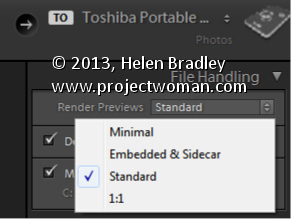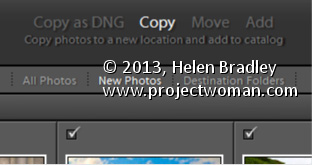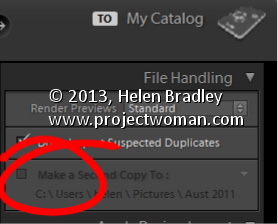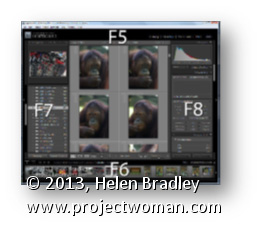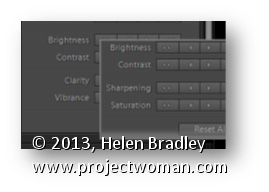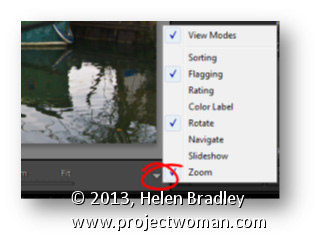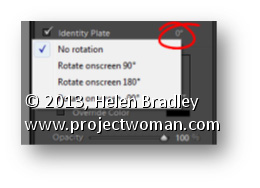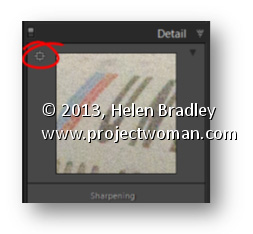Create a cancelled postal stamp watermark to use in Photoshop and Lightroom. See how to use the path tools to create the watermark and then save it as a png image with a transparent background so it can be used over your images.
This is the video explanation of the blog post on the same topic which you can find here:
Click Here for Photography School Tip Blog Post
Transcript:
Hello, I’m Helen Bradley. Welcome to this video tutorial. In this tutorial I’ll show you how to create a postage style copyright stamp that you can use on your images. In this tutorial I’m going to show you how you can create a copyright symbol like this which is a couple of concentric circles and some wavy lines and text. And it’s got an overall texture to it.
This is a tutorial that I created for digital-photography-school.com when one of my readers there was having a bit of difficulty following along. So that’s why I’ve created this as a video tutorial. And because of this I’m going to be doing it step-by-step as I did it for that particular tutorial on the Digital Photography School site. And you’ll see in the comments here just below the tutorial I’ve given you a link to that site if you want to follow along.
So the first thing that I did in that tutorial was to create a brand new image. So I’m going to do that now. I’m going to choose File and then New. And I’m going to do a letter size image, landscape. So it’s 11 inches wide by 8.5 inches tall, and it’s 300 pixels resolution, RGB color and the background contents are white. So I’m just going to click Ok. And here’s our starting image.
Now we’re going to add a new layer so I’m going to have my layers palette visible. So if you don’t have it visible choose Window and then Layers so that you can see it. And we’re going to add a new layer and we do that by clicking this little icon here. It’s the Add New Layer icon. It looks like I clicked it twice. So I only want one new layer here. And we’re going to draw our circles using the Ellipsis tool. And it’s here in the toolbar so let’s just have a look and see what we’re looking for.
We’re looking for this tool here. It’s the Ellipsis tool. And when you choose it you want to choose Paths from the tools option palette. Now the options are a little bit different in earlier versions of Photoshop. There are three icons here and you want to make sure that you click the icon that says Path when you mouse over it. They’re the exact same options. They just deliver differently. And this is Photoshop CS6’s version so I have Path selected.
I’m going to drag to draw an ellipsis, but you can see that this is going to be a sort of oval. I want it to be a circle so I’m going to hold Shift as I draw it. And if it’s not in the correct position before I let everything go I’m going to hold the Spacebar and move it into position, let go the Spacebar and just make sure that I have the outermost of my circles created. And when it’s dead right, I’ve still got the Shift key held, I’m going to let go of my Left Mouse button.
So now I have a circle the shape of this outer circle that we’re going to use. Now this is now going to be colored in and we want to stroke this circle. And we do this by going here to the Paths palette. Now the Paths palette you get to by choosing Window and then Paths. And the topmost path is going to be called your work path and that’s the one that you’re working with. This is this circle here. We want to stroke the circle with a brush so we’re going to go and select a brush to use.
So I’m going to click on my Brush tool and then I’m going to select the kind of brush that I want to use. And I’m going to use a hard sort of brush here. So I’m going to select that brush. It’s a hard brush. And let’s just check and see from the original tutorial just how big it needs to be. And apparently it needs to be 40 pixels. So let’s just take it up to around 40 pixels. That’s 39, but that’ll be fine.
I’m going to set black as my foreground color. So I’ve set my brush and my foreground color and what I want to do now is with this path selected I’m going to choose the option that says Stroke Path with Brush. So that’s this icon here. So I’ll click it to stroke the path with a brush. Now I’ve got a funny sort of stroke here and the reason is that my stroke is set to something I don’t want it to be set to. So let’s just wind that back with Edit, Undo.
Then I’m going to right click on this Path option here and choose Stroke Path. And I want to disable this option here, Simulate Pressure. I just want to stroke it with the brush so I’m going to click Ok. Now it’s working the way I want it to. So now I have my path stroked, well at least the outside stroked. Now I need to use the outside to make the inside because it’s going to be really easy to make a concentric circle. To do that I’m going to click on this tool here. It’s the Path Selection tool.
This is the one I want and it shares a position with the Direct Selection tool. But it’s the black one, the Path Selection tool that I want, and I’m going to click on my path so it is selected. Now I want to transform this. And the transformation handles have not appeared so I’m going to press Ctrl T to make them appear. I want to drag in on this handle. But I want to make sure that I don’t lose the circle and I want to make sure that I don’t lose the fact that it needs to be concentric. So I’m going to just hold down both Shift and Alt as I drag in on this handle. So let’s Shift Alt and drag inwards. And you can see that what I’m doing is making a concentric circle. It has the exact same middle as the original circle. I’m going to let go of my Left Mouse button and then let go of the shift and the Alt keys. Now my work path here is a much smaller path so I’m just going to click the checkmark here.
Now I’m going to do exactly the same thing. I’m going to select my brush and I’m going to stroke it, make sure black is my foreground color, and I’m going to stroke this path with the brush. And I get the exact same effect. Now what I need to do is to make a path for my type. And it needs to be a little bit bigger than this inside circle. So again, I’m going to click this Path Selection tool. I’m going to press Ctrl and T to show my handles, I’m going to hold down Alt and Shift, that’s Option and Shift on the Mac, and this time drag out just a little bit so that I get a path for my type, let go of the Left Mouse button, let go the rest of the keys and click the checkmark. Now I’m going to add my text. And to do that I’m going to select my Text tool and then select my type. And I want to use Myriad Pro.
So I’m going to go down here until I find Myriad Pro. And I think the type that I suggested in the article that we used was about 24 points so I’m going to click that. I have black as my type color. So everything looks pretty good. I’m going to hold my mouse over the line, over this path that is still selected, and when I do you’ll notice that the I-beam pointer changes from this I-beam to an I-beam with a short of squiggly line. That means I’m typing on the path. So I’m going to click to do that.
Now the first thing I need to do is to add my copyright symbol. So I’m going to hold down the Alt or Option key and type out 0169 on the keyboard because that gives me copyright, and now 2013, and I’m going to type my copyright details. And I think I’ll do this all in capitals. And I’m using Helen Bradley, projectwomam.com. And I think actually I just want to put a www in there so I’ll just arrow back and make that change.
Now so far my type hasn’t quite stretched all the way around my words. So the next thing we need to do is to stretch it just a little bit more. And I’m going to do that using the Character Spacing tool. So first of all, I’m going to make sure that all my text is selected and then I’m going to choose this dialogue here which will get me to the Character Spacing dialogue. Now this is two dialogues.
There’s a paragraph and a character, and we want the character. And what we want is this tool here, this VA tool. And it’s a scrubby slider so all I need to do is to adjust it a little bit. And can you see that the text is getting bigger every time I drag on it? And I think I’m going to wind that back just a little bit because I could probably add a trailing dash to this. And that’s now all the way around that shape. And let’s just up that to bold because I don’t think it’s really quite dark enough for me. And if I’m using bold I’ll going to have to wind back up on my character spacing a little bit. And so now I’ve created my text on a circle.
Now the only thing that I’m a little bit concerned about is I think that this circle could be a little bit smaller. So I’m going to reselect my text layer here, and again with Alt and Shift selected, I’m going to drag inwards just a little bit to resize that circle path that the text is on because I just think it was a little bit on the big side. So I’m a little bit happier with my text now.
So we’re ready now to go ahead and to create the wavy lines. And we’re going to do that by clicking on the Custom Shape tool here that shares that toolbar position with the Ellipse tool that we used earlier. But this time we want Custom Shape. And from the Shape dropdown list here what we’re looking for is this wiggly line wave shape. Now this is shipped with Photoshop so you will have the wave shape. If you don’t have it in your collection you can click this little fly out arrow and choose All to add all the shapes or append all the shapes to your shapes collection. But this is the one we’re using.
I’m going to drag the shape onto my image and then use the Path Selection tool to just move it into position. Now at the moment it’s a series of closed paths and I want to open these paths. And I’m going to do that by clicking here on the Add Anchor Point tool. Unfortunately you can’t just delete points in Photoshop to open up these curves.
We first of all have to add a point in here that we can then go and delete to open it up. It doesn’t work otherwise. It’s a bit of a nuisance. But this is how we’re going to do it. So I’m going to click once with this Add Anchor Point tool on the ends up all of the shapes. And now I’m going back to the Direct selection tool. And I’m going to make sure that I’m selected on this point that I just added, so it’s black and everything else around it is not, and I’m going to press the Delete key. And that will just break that path in two. And I’m going to repeat that for each of these points.
So select it and press Delete, select it, press Delete, select it, and press Delete. Now if Photoshop is running out of memory if you’ve been using it quite a bit, you might find as I just did earlier that that was not working. Every time I pressed Delete the entire path was going. So I just closed down Photoshop and reopened it and went back to where I was working and it’s working perfectly. So now I have my lines. And you’re probably beginning to see a pattern here because this is just another path. And we can stroke it because we have our tool that we can stroke it with.
So I’m just going to go back and make sure my brush is selected. The same brush is selected, black paint, click on the work path so that I have it selected and now I’m going to stroke it. And that is giving us our lines. And so if you wanted to leave it at this point you could because everything is in place. But I’m going to go ahead and add a Grunge effect to it.
Now we’re ready to create our Grunge effect. And to create that, first of all what we need to do is to flatten the image. But in flattening it I need to remove the white layer from the flattened version. That is because later on when I will put this copyright image over my photograph I want the background to be transparent. So I want to keep this white layer out of the action right now. So I have two visible layers. I’m going to click on the topmost layer and press Ctrl Alt Shift and E to create a new flattened version of this layer. So this is the version that I’m going to use. And now I’m going to bring in a texture layer.
So I have a texture image open here, and I think it’s a really nice texture to use. So I’ve got the texture open. And to add the texture to this particular layer I’m going to select the layer and click the Add Layer Mask icon because that adds a layer mask to the image. And now this texture has to be made the exact same size as this image so I’m going to choose Image and then Image Size. And I want to resize it to the exact same size as this one.
So I can do that by just clicking Window and just pointing to the image whose size I want to borrow. And that’s apparently the size of this image here so I’m just going to click Ok. And because it’s a texture image it doesn’t matter that I’m skewing it a bit out of proportion because nobody really knows what a scratch is supposed to look like. Having done this, and it’s critical that you resize the texture to the exact same size as this image or you can’t use this next technique, which is to apply the texture as a mask.
So I’m going to click on the mask, and I’m going to choose Image, Apply Image. And if you don’t have the texture file the exact same size it will not appear here. So it does obviously appear here so that’s exactly what I want. I want to apply the texture to the image. And at the moment it’s set to Multiply blend mode. But I can test other blend modes and I can even test inverting the layer. So I’m just going to look for the best effect that I can get here.
In fact in the tutorial I suggested that we use Hard Light. So that looks like the one that we’re going to use, Hard Light. So I’m just going to click it and click Ok. And that gives us the sort of texturize look to our shape. And again, I was going to create this as a new layer so I’ll click on this layer and again press Ctrl Alt Shift and E to gives me a newly stamped layer. Well it’s not appearing to work right now. So let’s just add a new layer and press Ctrl Alt Shift E because that will work. And then we’re going to save this as a PNG image. But before I do it I think it’s going to be cropped because I think it’s a bit too big at this stage.
So I’m just going to crop down to get rid of the bits of the image that I don’t want and click the checkmark. And now I’m going to save this but making sure that I have this background turned off because I want it to be a transparent image. So I’m going to save it as a PNG image. So I’ll choose File, Save as, and I’m going to call this HB copyright, black, and PNG. And I’m going to make sure that I select PNG from this list here. And here’s PNG. So I’m going to select it and just click Save and click Ok. And that’s now saved as a PNG image.
Having done that I then want to make it white. So I’m going to choose Image and then Adjustments and then I’m going to invert it so what was black becomes white. And now if I just test this with a black filled layer behind it, you’ll see that it’s now a white image. So we could use that to go over the top of for example a very dark image.
So having created that I’m going to turn off my background because I want this to be a transparent image, and I’m going to resave it this time as a PNG. But this time I’m going to call it white. So again, this is going to be HB copyright, and it’s going to be white, PNG. I’m going to save it as a PNG image, and Ok. And so this is now the copyright image that I can use on my images in future.
I’m Helen Bradley. Thank you for joining me for this video tutorial. And look out for more of my tutorials both on digitalphotographyschool.com and also on my own website at projectwoman.com.


